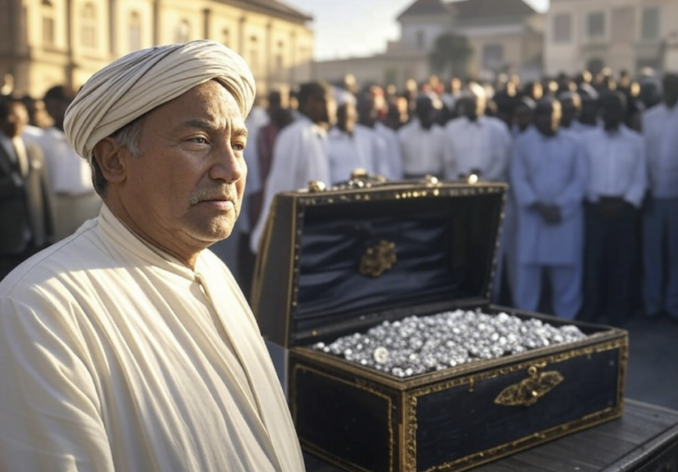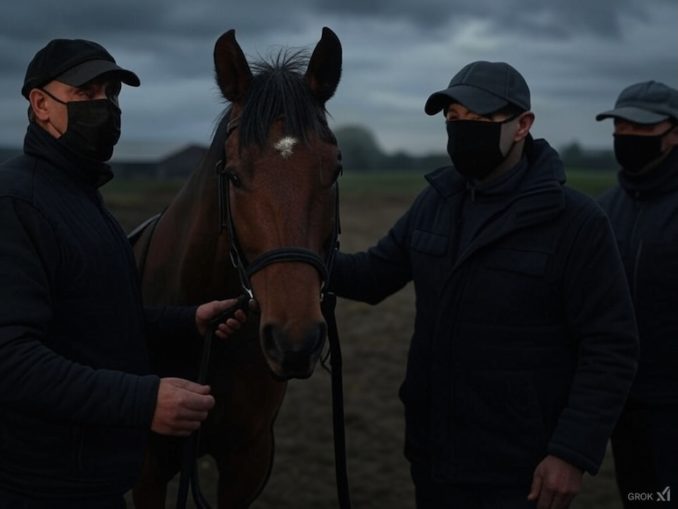When Aga Khan III died, it was a difficult act to follow, especially since the title skipped a generation and found itself resting upon the shoulders of 19-year-old Prince Karim Al Husseini, who we know as THE Aga Khan and who passed away recently in Lisbon aged 88. His grandfather, Sir Sultan Muhammed Shah Aga Khan III, had an interesting life that included being elected president of the League of Nations Assembly in 1937 and being weighed in diamonds — not once, but twice.
A March 1946 a Reuters dispatch from Bombay announced that before 70,000 people, including a number of ruling princes, the Aga Khan was weighed against diamonds in the Brabourne Stadium. The scale balanced at 17st 5lb 8oz. The occasion was the diamond jubilee of the 68-year-old, who could trace his descent directly from Mohammed’s son-in-law, Ali, and who had for 60 years been the spiritual leader of 20,000,000 Ismaili Khoja Muslims in Asia and Africa. The presentation of the diamonds (valued at £640,000) was purely ceremonial to determine the sum to be applied to the social welfare of the Aga Khan’s poorer followers.

Five months later, the ceremony was repeated in Dar Es Salaam, raising another £640,000. At the time, the Aga Khan was thought to have an annual income of about £450,000 from tithes paid by his followers and to be worth a cool £600 million. Not a stick insect at 17st 5lb 8oz, and living well and investing in the Turf after ‘social welfare’ obligations had been covered, the Aga Khan’s health didn’t thrive alongside his wealth. In 1947, he required an operation.
In August of the following year, the newspapers reported that Aga Khan III had cancelled all further engagements in East Africa for health reasons, though his symptoms were underplayed. Arriving in Nairobi from Zanzibar, where he had been suffering from a ‘chill’, he planned to leave for Europe by air within a few days. Another operation followed.
Dividing his time between his faithful followers on the subcontinent and East Africa and his numerous European properties scattered around Paris, the Riviera, and Switzerland, a decade later (and following a third operation) for his platinum jubilee, he returned to Karachi — the city of his birth — to be weighed in platinum. The celebration was marked by a 210-page souvenir book published in English and Gujarati featuring Aga Khan III and his favourite and eventual sucessor, Prince Karim, on the front cover.
They say that health is wealth. They are correct. Despite riches beyond avarice, his health was failing further. Another operation followed, with dispatches noting the Aga Khan’s condition to be “stationary” after a restful night:
‘The Aga Khan passed a comfortable night, and his condition was stationary this morning,’ a member of his household at Cannes said. He has been suffering from heart trouble and arthritis since he returned to his Riviera villa from Egypt last week.’
Four years later, his condition had become so grave that he was flown from Paris to Geneva in a chartered Viscount airliner to an ambulance that took him to his lakeside mansion, Bakarat, at Versoix, a few miles outside of Geneva.

There, he died on 11th July 1957 in his 80th year. One of the biggest buyers of bloodstock in the history of the Turf, he took more than a million pounds in prize money in 36 years of racing in England, Ireland, and India.
Three years later, with Prince Karim installed as Aga Khan IV over the head of his father, tragedy struck when that father, Prince Aly Khan, was killed in a car crash. Accompanied by his mother, Princess Joan, Aga Khan IV dashed to a mortuary in the Parus suburb of Puteaux near to where his father had been killed.

Prince Aly Khan’s constant companion Bettina — a dark-haired French mannequin (as described by Parisian scandal sheets) survived the crash despite sitting beside him in his grey Lancia when it collided with a French saloon car. She sustained only minor injuries and spent the night with friends after receiving treatment.
Prince Aly Khan, 48, suffered a broken neck and a crushed chest in the accident. Dressed in evening attire, he died en route to the hospital. The other driver, M. Charles Bichaton, escaped with minor injuries. Witnesses reported both cars were travelling at approximately 60 mph (37 km/h), with the police finding no evidence that speeding was a factor in the crash.
Besides horses, the Aga Khan had an interest in skiing. In January 1964, as a long spell of fine weather broke and clouds massed around the north wall of the Eiger, he was in Switzerland taking part in the pre-Olympic men’s Lauberhorn races at Wengen. Later that month, he represented Iran in the Winter Olympics, held over the border in Innsbruck.

Competing in the men’s downhill, the highest-placed British competitor was a 24-year-old medical student called John Rigby, who finished 44th. Puffins of a certain vintage will be familiar with 1990s society ‘It girl’ Tara Palmer-Tomkinson. Tara’s father, Charles, finished 56th on the icy Patscherkofel course in front of 40,000 spectators. Three places behind him came the Aga Khan, who finished 59th in 2 minutes 18.16 seconds.
After the competition, Charles made a telling comment regarding changing times. Following his disappointment, Mr Palmer-Tompkinson mentioned to waiting journalists:
“The thing about racing nowadays is that you have to train for months and months in advance. It is no longer a genuinely amateur sport since it is becoming more difficult to fit anything else in with it.”
Charles (rightly) retired from competitive skiing and, after returning to his country estate in Hampshire, concentrated his energies on a real estate business in London. The Aga Khan concurred and thenceforth enjoyed the horses he had inherited from his father and grandfather.
Later in 1964 lightning almost struck twice when the 26-year-old escaped unhurt in a car accident in Paris, only a few hundred yards from the crossroads where his father had died. He was driving a car that collided with another on a hill in the suburb of Suresnes. It had been in a Suresnes hospital where his father had died.

Also in 1964, the Aga Khan married British model Sarah Frances Croker Poole who became known as Begum Salimah Aga Khan. Together, they had three children: Princess Zahra (born 1970), Prince Rahim (born 1971), and Prince Hussain (born 1974). The couple divorced in 1994. In 1998, the Aga Khan married Gabriele Renate Thyssen, who took the name Begum Inaara Aga Khan; they had one son, Prince Aly Muhammad (born 2000), before divorcing in 2014.
Throughout this period, the Aga Khan expanded his philanthropic vision, establishing the Aga Khan Development Network (AKDN), which operates in over 30 countries. The AKDN focuses on areas such as healthcare, education, cultural preservation, and economic development, aiming to improve living conditions and opportunities, particularly in developing regions.
Beyond his philanthropic endeavours, he was known as an accomplished businessman with interests spanning luxury hotels, real estate, and media enterprises. He also remained a passionate equestrian, renowned for his success in horse breeding and racing. One notable stallion being Shergar, the legendary Irish racehorse and 1981 Epsom Derby winner. On 8 February 1983, Shergar was kidnapped from Ballymany Stud in County Kildare, Ireland.

Armed men, believed to be members of the IRA, forced groom James Fitzgerald to hand over the horse. Despite demands for a £2 million ransom, negotiations failed and Shergar was never seen again. His fate remains a mystery, with speculation that he was killed shortly after the abduction. The case led to one of racing’s greatest unsolved crimes. No arrests were ever made.
In his later years, the Aga Khan resided in France and Portugal, obtaining Portuguese citizenship and making Lisbon a central hub for his activities. His eldest son, Prince Rahim Aga Khan, succeeds him as the 49th Imam of the Ismaili Muslim community.
Another interesting life beckons!
Images generated using GROK AI
© Always Worth Saying 2025


